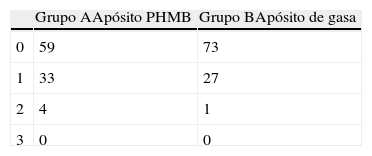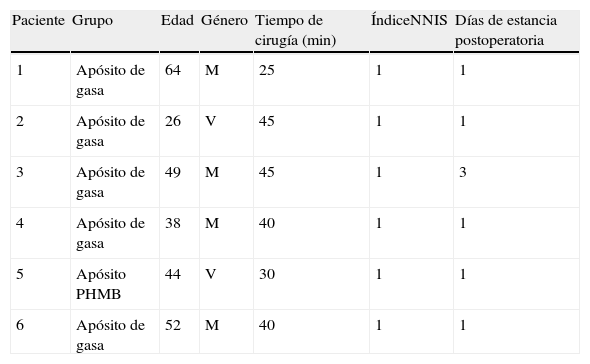Analizar la efectividad de un apósito de polihexametileno biguanida al 0,2% frente a la infección superficial de la herida quirúrgica en pacientes tras la realización de una colecistectomía laparoscópica.
MétodoEstudio randomizado simple ciego longitudinal con 2 grupos de asignación aleatoria en los que se han incluido a pacientes diagnosticados de colelitiasis y a los que se les va a realizar de manera electiva una colecistectomía laparoscópica. La variable de eficacia principal o variable dependiente es la infección superficial del sitio quirúrgico siguiendo los criterios de los CDC (1999) y como variables independientes la utilización de un apósito de polihexametileno biguanida al 0,2% (grupo A) o apósito de gasa no oclusivo (grupo B). Se utilizó el índice NNIS para evaluar el riesgo de infección. Utilizamos el test χ2 o test de Fisher para evaluar la asociación entre las variables independientes.
ResultadosSe reclutaron 197 pacientes, 96 (48,7%) del grupo A y 101 (51,3%) del B. No se encontraron diferencias estadísticamente significativas en cuanto al género, tiempo empleado para la cirugía (51,4±21,2min vs. 52,6±23,4min para A y B) e índice NNIS en ambos grupos. Aparece una infección superficial de la herida en 6 pacientes (3,04%), una en el grupo A (1,04%) frente a 5 en el grupo B (4,95%).
ConclusionesEn nuestra serie no se ha relacionado la infección superficial de la herida quirúrgica con el tipo de apósito empleado (p=0,212), aunque no es posible descartar esta asociación ya que el estudio no tiene suficiente poder para hacerlo.
To analyze the effectiveness of a 0,2% polyhexamethylene biguanide dressing against the infection of a superficial surgical incision site (ISSIS) after a laparoscopic cholecystectomy.
MethodA randomized longitudinal single-blind study was conducted with two randomly assigned groups consisting of patients diagnosed with cholelithiasis soon to undergo an elective laparoscopic cholecystectomy. The dependent variable was ISSIS using the criteria of the Centre for Disease Control (CDC) (1999). The independent variables were the use of a 0,2% polyhexamethylene biguanide dressing (Group A), or a non occlusive dressing (Group B). The National Nosocomial Infections Surveillance (NNIS) index was used for assessing the risk of infection. The χ2 test or Fisher test was used to evaluate the correlation between the independent variables.
ResultsOf the total 197 cases, 96 (48.7%) were in group A and 101 (51.3%) in group B. No statistical differences were found between genders, duration of surgery (51.4±21.2 vs 52.6±23.4minutes, in group A and B, respectively), or the NNIS index in either group. Six patients had an ISSIS (3.04%): 1 in group A (1.04%) and 5 in group B (4.95%), P=.212.
ConclusionsThe study was unable to correlate an ISSIS with the type of surgical dressing that was used, although it was not possible to rule out an association, as the study did not have sufficient statistical power.
Artículo
Comprando el artículo el PDF del mismo podrá ser descargado
Precio 19,34 €
Comprar ahora








